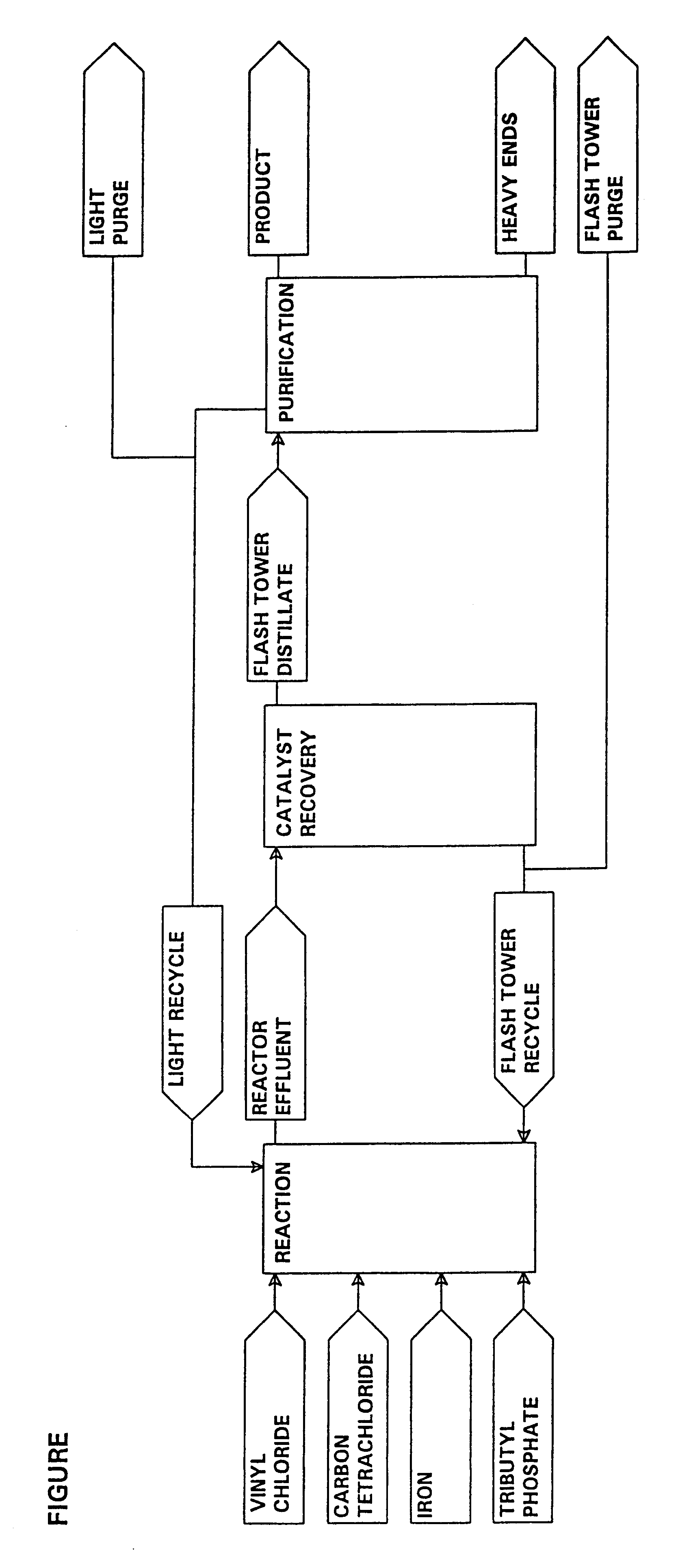Process for the manufacture of 1, 1, 1, 3, 3-pentachloropropane
a technology of pentachloropropane and process, applied in the field of improvement, to achieve the effect of reducing the time required and increasing the degradation rate of the flasher bottom liquid
- Summary
- Abstract
- Description
- Claims
- Application Information
AI Technical Summary
Benefits of technology
Problems solved by technology
Method used
Image
Examples
example 1
Production of 1,1,1,3,3-Pentachloropropane at a High Carbon Tetrachloride to Vinyl Chloride Feed Ratio
A pilot plant was constructed as shown in the FIGURE of the drawing using a 10 gallon glass-lined reactor and a nickel flash tower. It was operated at the conditions listed in Table II below. These results illustrate that the novel production process efficiently converts the vinyl and CCl.sub.4 feed materials to 1,1,1,1,3,3-pentachloropropane (HCC240fa) at a CCl.sub.4 to vinyl molar feed ratio of 1.7. The results presented are the average of eight samples. In this table and in the following examples, the selectivity to HCC240fa is estimated as the number of moles of vinyl chloride converted to HCC240fa divided by the number of moles of vinyl chloride converted to all products. In this and the following examples, the residence time in the flasher is calculated as the liquid inventory in the flasher and reboiler [lb] divided by the rate of flash tower purge [lb / day]. The inventory in ...
example 2
Production of 1,1,1,3,3-Pentachloropropane at Low Carbon Tetrachloride to Vinyl Chloride Feed Ratio
The pilot plant process described above was operated at the conditions listed in Table III below. These results illustrate that the novel production process efficiently converts the vinyl and CCl.sub.4 feed materials to 1,1,1,3,3-pentachloropropane at a CCl to vinyl molar feed ratio of 1.3. The results presented are the average of eight samples.
example 5
Effect of Iron Metal in the Flash Tower
Examples 5 and 6 will show that the presence of iron metal powder in the flasher increases the rate of degradation of the flasher bottoms liquids. The present example is the control test, with no iron metal added.
A sample of flasher bottoms liquid taken from the pilot plant flasher was placed in a glass flask fitted with a magnetic stirrer, a reflux condenser and a nitrogen pad. The reaction mixture was heated and stirred at 105.degree. C. under nitrogen for a period of five days. Several samples of liquid were taken during this time and analyzed via gas chromatography. Results are shown in Table IV below. No solids were present after heating for 2.9 days. Black solids had formed and were stuck to the glass flask walls as 3.9 days had elapsed. The concentration of tributylphosphate (TBP) had declined from 3.1 wt % to 2.1 wt % after 2.9 days, and finally to 0.4 wt % after 5.0 days. Dehydrochlorination of HCC-240fa had produced only 0.02 wt % 1,1...
PUM
| Property | Measurement | Unit |
|---|---|---|
| Time | aaaaa | aaaaa |
| Angle | aaaaa | aaaaa |
| Fraction | aaaaa | aaaaa |
Abstract
Description
Claims
Application Information
 Login to View More
Login to View More - R&D
- Intellectual Property
- Life Sciences
- Materials
- Tech Scout
- Unparalleled Data Quality
- Higher Quality Content
- 60% Fewer Hallucinations
Browse by: Latest US Patents, China's latest patents, Technical Efficacy Thesaurus, Application Domain, Technology Topic, Popular Technical Reports.
© 2025 PatSnap. All rights reserved.Legal|Privacy policy|Modern Slavery Act Transparency Statement|Sitemap|About US| Contact US: help@patsnap.com

